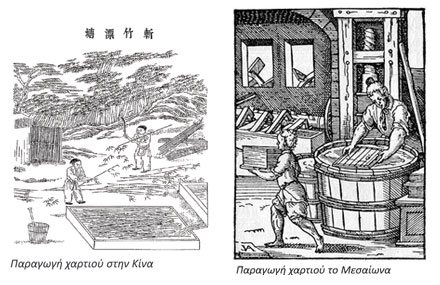It all started in 751, during the conquest of Turkestan. In a battle between Arabs and Chinese, the Arabs captured in Samarkand (capital of the homonymous province in the Republic of Uzbekistan) two Chinese soldiers, papermakers by profession, and with their help, the governor of Baghdad (739 A.D.) founded a paper mill at the place of their arrest, a place suitable because it had enough water and was rich in flax and hemp crops, which were the manufacturing raw material of the time. The oldest dated Arabic manuscript found written on paper is of 866.
Very soon, paper became valuable and sought after commodity in all countries of the Middle East. Almost immediately more paper mill industries were established in Aleppo, Damascus, as well as in other Muslim cities; Damascus was the main source of paper for Europe.
By the name of one of these cities, the new writing material was often called “vamvykinos”, which can be satisfactorily explained only if we associate the word with the city Vamvyki on the west of Euphrates, between Antioch and Edessa, which was probably the import or spread centre of the Arabic paper.
The form “vamvykinos” as paper made of cotton, considered eastern type, unlike paper made of cloth, western type, seems to be a myth, supported by the existence of the Greek word “vamvakon”. In fact, it was believed that paper, in any case, was mostly made by cloth and the so-called eastern making differed from the western one only in the material used for gluing. Only in this sense one can use the terms, standard in the lists of manuscripts, “vamvykinos” (eastern manufacture) and “chartoos” (western manufacture).
Finally, paper manufacture was soon spread to Minor Asia, and thence to North Africa, Morocco 1100 A.D., Sicily, and it arrived in Spain in the 12th century, following the Arab conquests. In the 14th century almost all European countries had paper mills.

Paper in East and West
The hostilities between Arabs and Byzantines may have had an adverse impact on trade, but there is no doubt that since then the use of paper passed to Byzantium.
Of course, the major effects of the new arrival were not immediately felt. The earliest references identified about “vamvykina”, unlike parchments, date back to the second half of the 11th century and are found in the historian’s Michael Attaliates work “Ordinance” and at the beginning of the next century in the Empress’s Irene Komnene (Doukaina) work “Typical”. As we can see in imperial documents, paper began to be used from the mid-11th century and beyond. The oldest Byzantine paper document is the Golden Bull of Constantine Monomakh for the Great Lavra Monastery in June 1052.
The paper imported from the Arab states was used before the late 11th century by the Secretariat of the Norman kings of Sicily in imitation of Arabic literature. Then, about the mid-12th century it was used in Genoa because of the city’s relationships with the Byzantine world that used extensively for almost a century the Arabic manufacture paper. Thereafter, the Spanish paper is imposed, less nice than the original Arabic paper, but more accessible and cheaper.
Finally, the Italians manufacture their own paper with the first successful attempts taking place in the area of Genoa around 1210 and later in Fabriano. In the five centuries following the manufacture of paper by the Arabs in the East, the paper production was increased and systematized in the East and the West.
From the mid-13th century, both known types of paper, eastern and western, flow into the Byzantium, leading to a cheap writing material available to the intellectual production.
After Fabriano, paper mills were established in other cities of Italy as well. These cities used to be the source-paper for Germany until the early 14th century, when its own factories were established, usually installed in watermills, where the motive power of the water was used to make paper pulp.

Processing and manufacturing
For paper making people were grinding the raw material (linen, cotton, straw, wood) in water and, for smoothing, they were using a manual mill with wooden battledores.
In the late 13th century, in Fabriano Italy, they exploited the water power to propel metal pistons for grinding the wet material. Then, they used to place the pulp in a vat while the artisans were holding a mold (a kind of disc with a wire mesh at the bottom) which adjusted the size and the edges of the paper.
They used to plunge the mold into the pulp and to draw it out with the surface up. The left-over pulp was drained by the mesh. They shook the mold for the pulp to settle on the mesh while the artisan removed the wooden frame and gave the mold to another worker who used to put the paper with the mesh onto a pile of woolen cloths (felts). They were waiting until the paper was dry enough and took it out of the mesh and placed it on the cloths, putting over it another sheet of felt, continuing the same work until stacking about 100 sheets of paper, every sheet placed between two sheets of felt.
Then, they carried the pile of wet paper and the cloths to pass them through a press. The paper was dried and was usually hung on thin hair-ropes. Finally, they plunged the sheets of paper one-by-one in a gelatin solution made from animal hooves, horns and skins. The paper was dried one more time and its hard and waterproof surface was suitable for writing with a goose feather.
Although this surface was not at all suitable for printing in the Chinese manner, in which wooden figures were used, they discovered that it was possible to print on both sides of paper by the use of metal figures and manual press.
This epoch-making invention is partly due to Johannes Gutenberg (1400 – 1468), the German regarded as the inventor of movable type printing. It is true that the invention of typography influenced significantly the production of paper. The demand for printed works and therefore the demand for paper were skyrocketed by typography. Perhaps not accidentally, the development of typography and circulation of printed works coincided with the period of the Renaissance.
Until the 18th century, papermaking methods remained the same, but the raw materials were not enough and the researches turned in other directions for the discovery of new materials for the manufacture of paper and its mechanical preparation because, until then, the paper was manufactured by hand and this slow process was uneconomical.
In 1765, priest Saifrer recommended the use of wood for paper-pulp. Several new methods for making paper-pulp were developed subsequently, which replaced the old ones.
These methods are divided into two categories:
- The first one was related to the separation of fibers and pieces of wood with the aid of mechanical means.
- By the second method, the wood was immersed in chemical solutions.
The wood-pulp manufactured by chemical means contained all the components of wood and thus was not suitable for the manufacture of high-strength white paper. On the contrary, the chemical paper-pulp was used with satisfactory results in the manufacture of white, high-strength and long-endurance paper in all uses. In 1798, the Frenchman Nicholas-Louis Robert invented a machine for paper production, the basic principle of which was to produce smooth continuous paper in rolls and no longer in individual sheets. Unfortunately, he did not find investors to sponsor his studies and the project was abandoned, until the Fourdrinier brothers heard about this project and decided to construct their own paper making machine, which they patented globally in 1807. Although they never used it, the machine for making paper in rolls went down in history with their name.
Two years later, the Englishman Dickinson invented a cylindrical paper-making machine, the forerunner of today’s paper-making machines.
Around 1850 the German Friedrich Gottlob Keller thought to smash wood by a wet millstone, converting it to low quality paper-pulp. The same manner was used by Charles Fenerty. At that time, in the 19th century, timber was abundant and cheap and, being rich in cellulose, was the most suitable material for paper production, solving the problem of shortage of raw materials that had began to appear.
For this reason, many scientists involved with this issue.
In 1851, the Englishman Hugh Burgess first used chemicals to dissolve wood into pulp. Together with Charles Watt they developed the alkaline process for making paper from wood-pulp. Following the example of Hugh Burgess, in 1866 the American chemist C.B. Tilghman improved this process by using sulfuric acids.
In 1879, the Swedish C.F. Dahl introduced additional sulfuric acids in the process, resulting in the Kraft (from the German word for power) recipe for paper production. The Kraft process was applied in America in 1907, where the mass production of paper was a reality (paper production was doubled and reached 2.5 billion tons per year).
In this phase, the global potential based on the use of timber dominated in 20th century’s paper production, as industrial productive processes spread quickly. Soon, many people realized that, at the rate the production progressed, an alternative raw material other than wood should be found.
One of them was Henry Ford, an advocate of the use of agricultural residues to produce goods. Every Ford car was using a large amount of soy until 1934. However, the manufacturers proved unable to start an industry based entirely on agricultural residues.
At the same time, as the use of paper had reached the heights, a large paper mass was observed in the waste and the idea was born to use these waste due to lack of raw material, especially during the two world wars. In this way, a solution to the problem was found, which also helped the field of ecology. Once it was found that by recycling the paper thousands of trees are saved, recycling became one of the objectives of ecological organizations together with the elimination of chlorine used to bleach the paper-pulp.
Nowadays in Europe the recycling rate has auspiciously exceeded 66% (in particular, it reached 52.7% in 2002). Greece reached a recycling rate of 30.6% in 2002, very low compared with that of Sweden, for example, which was 86.4%.





Leave A Comment